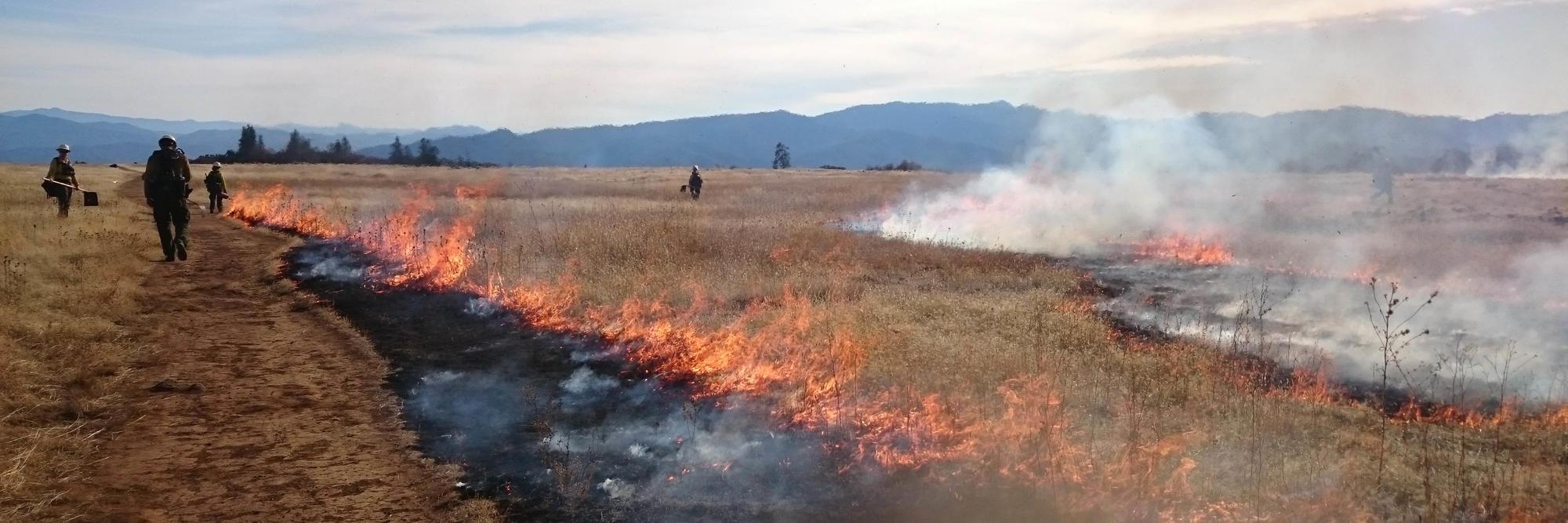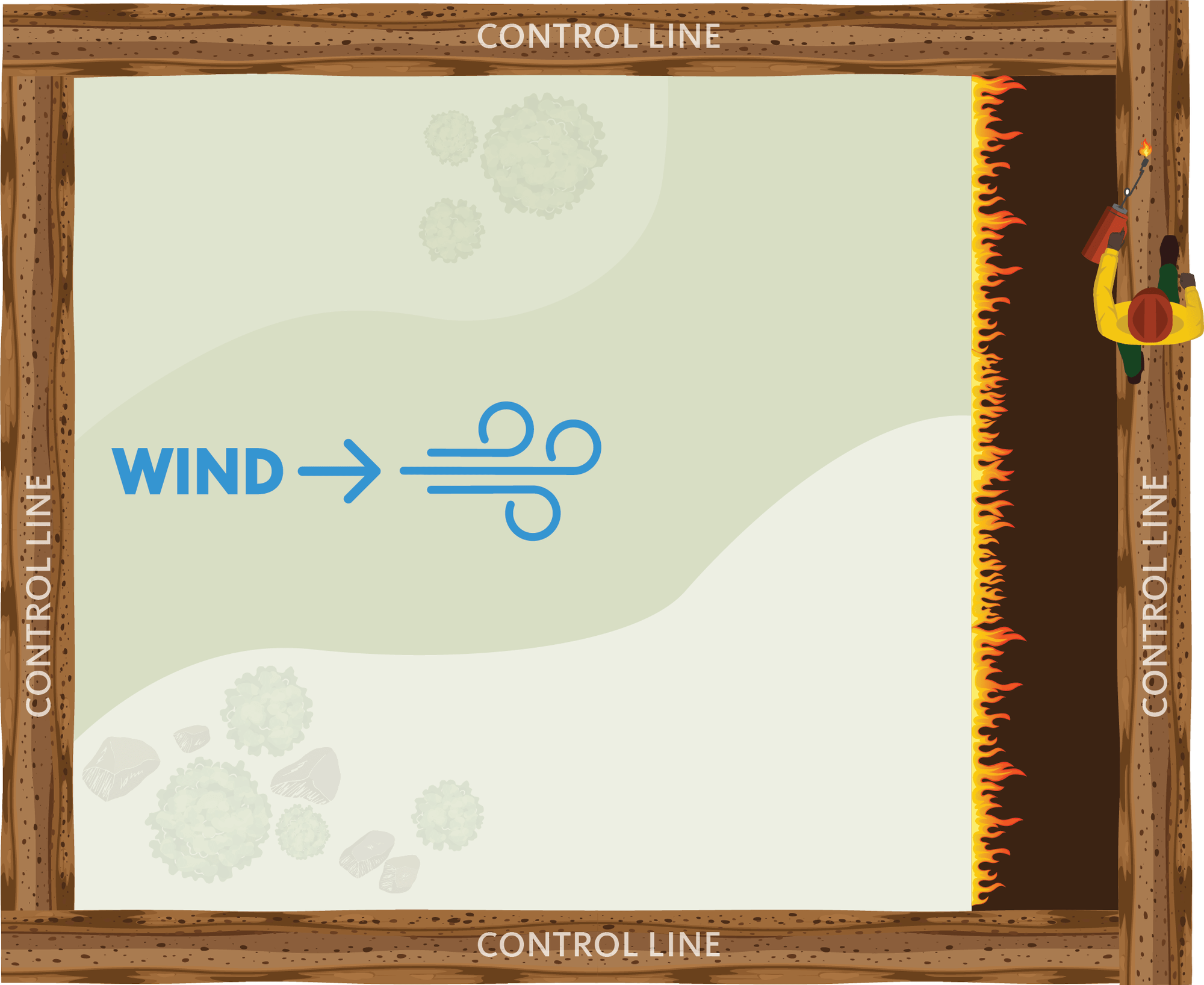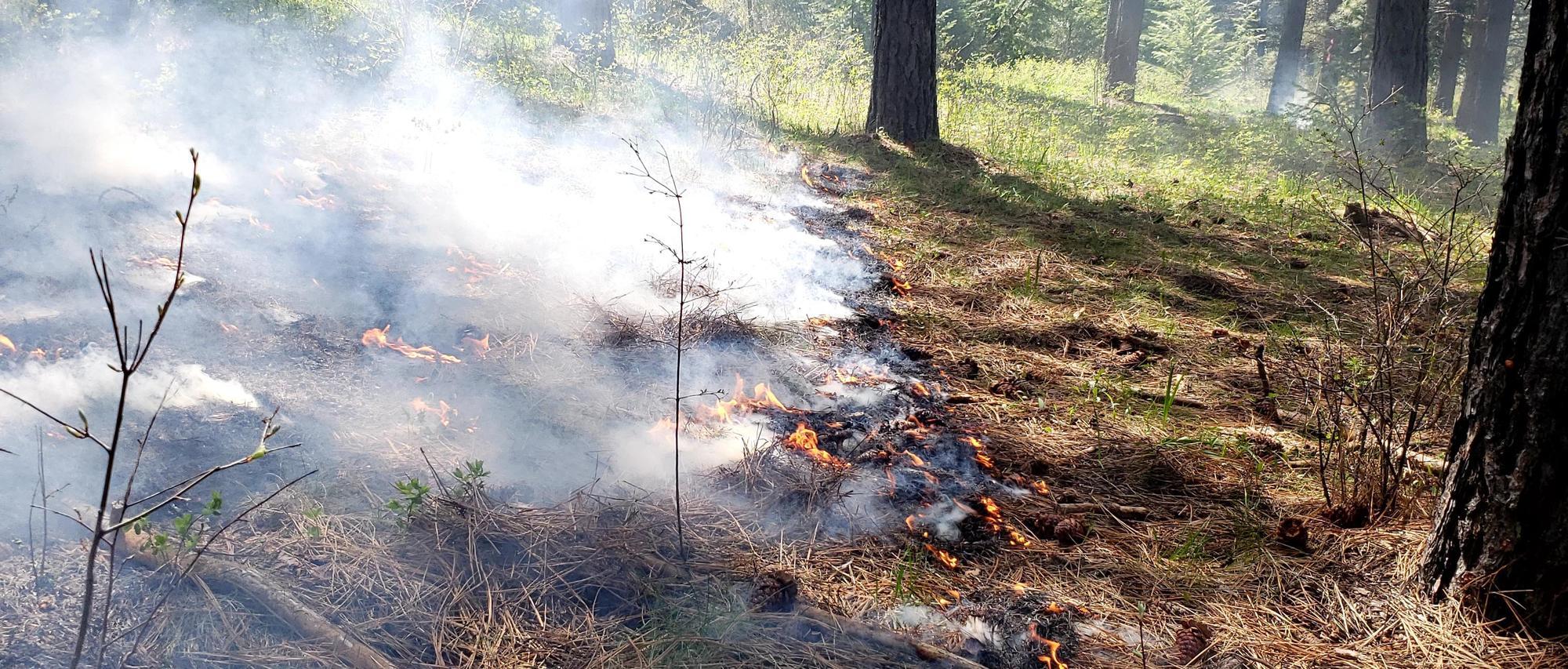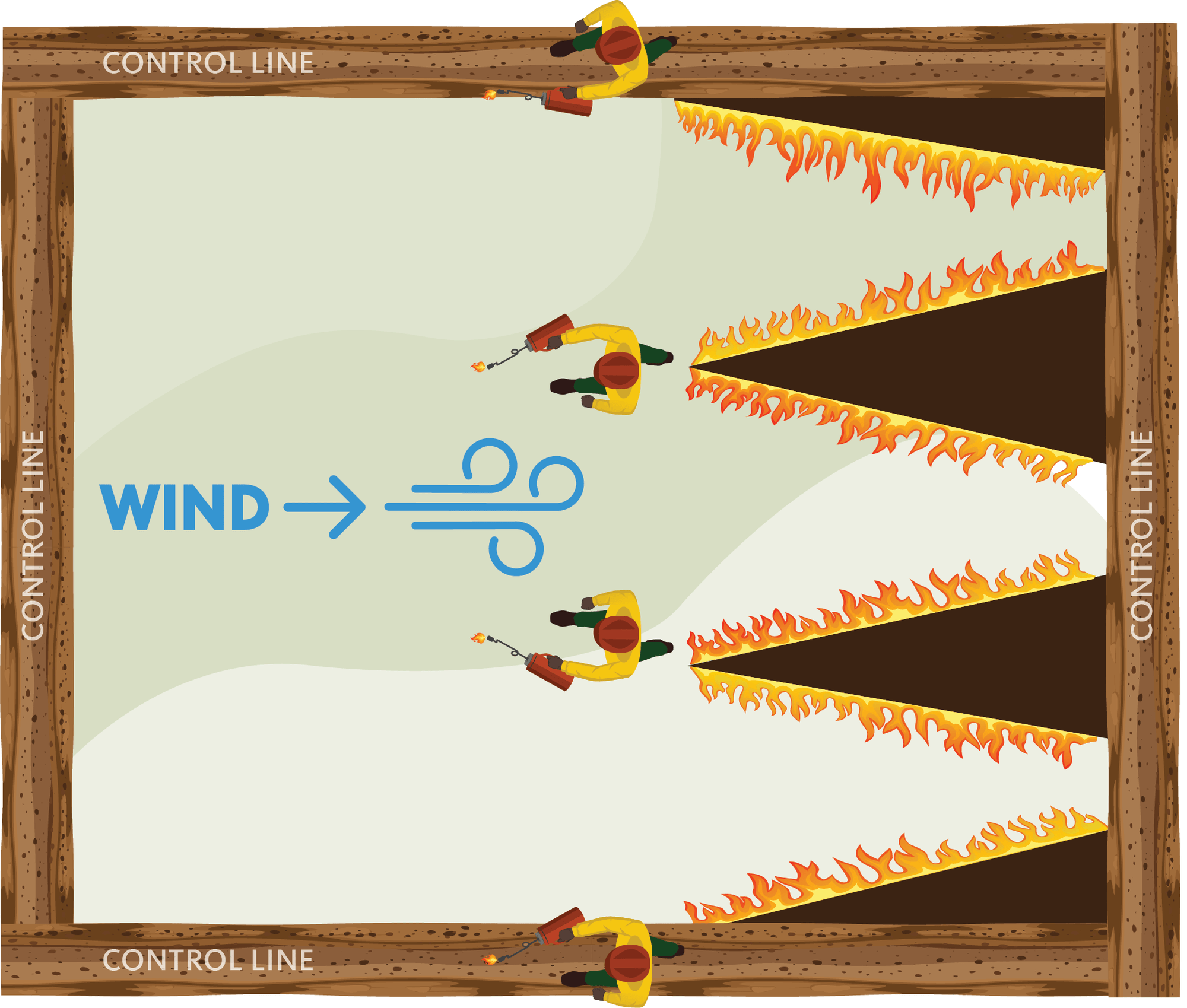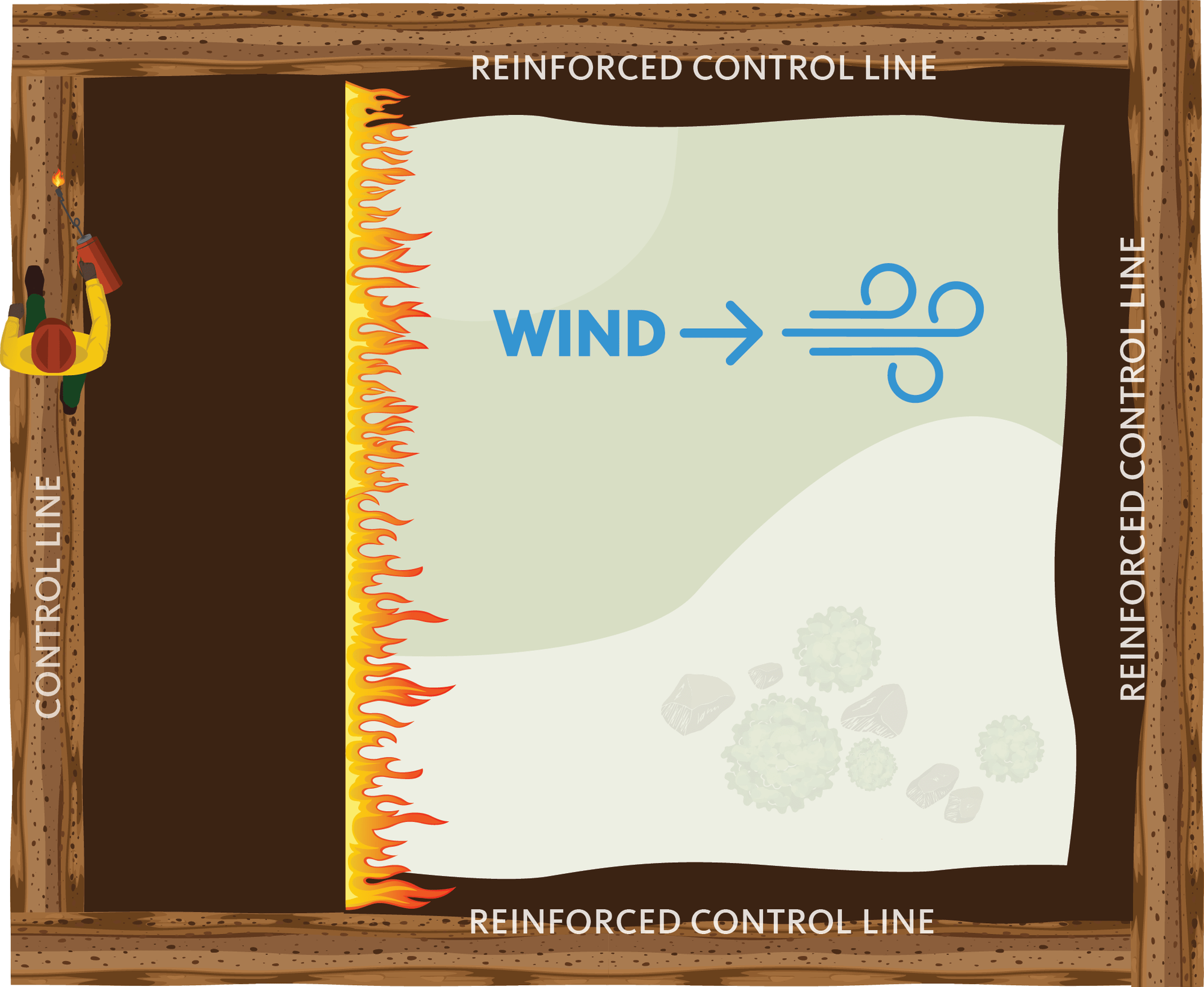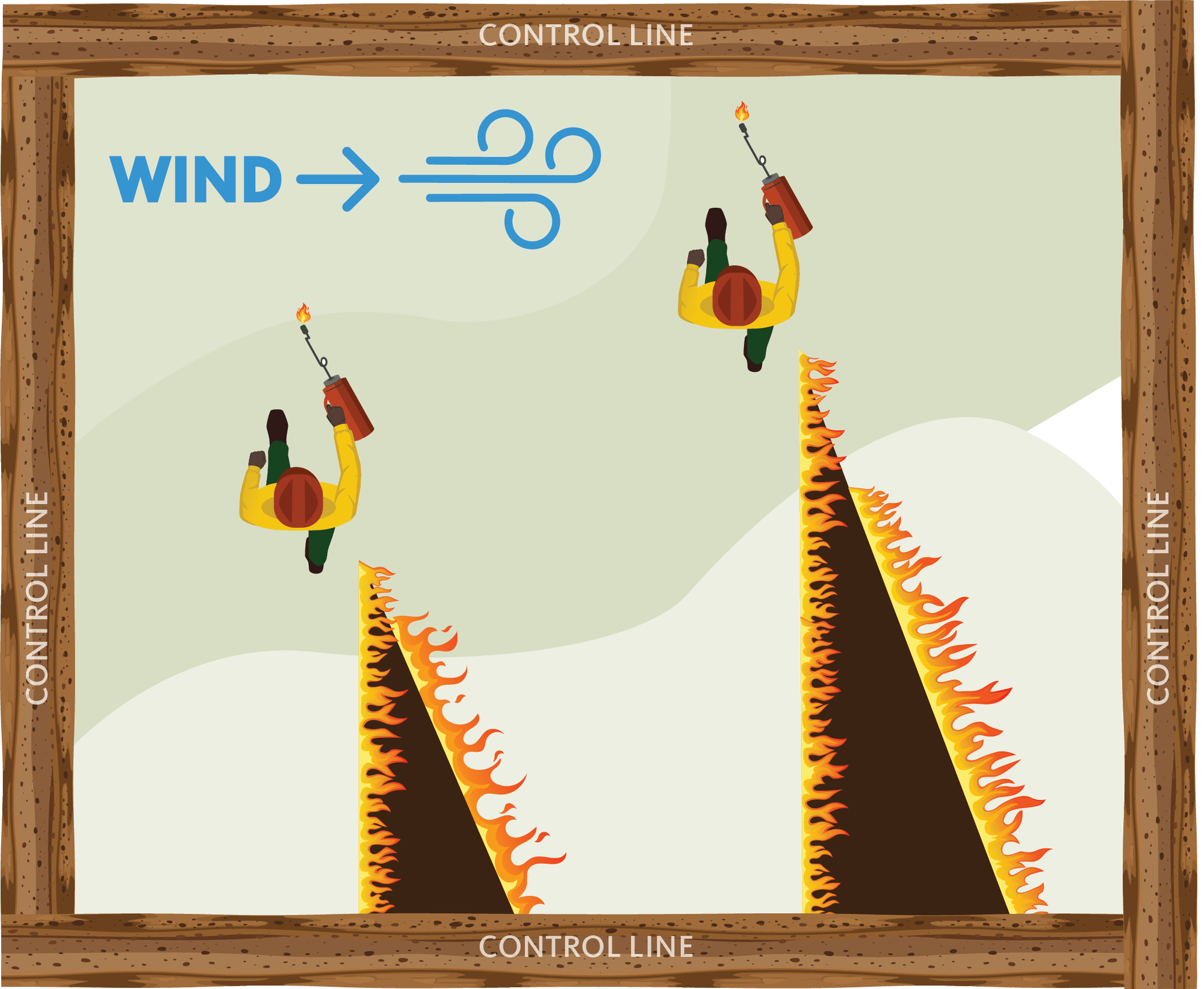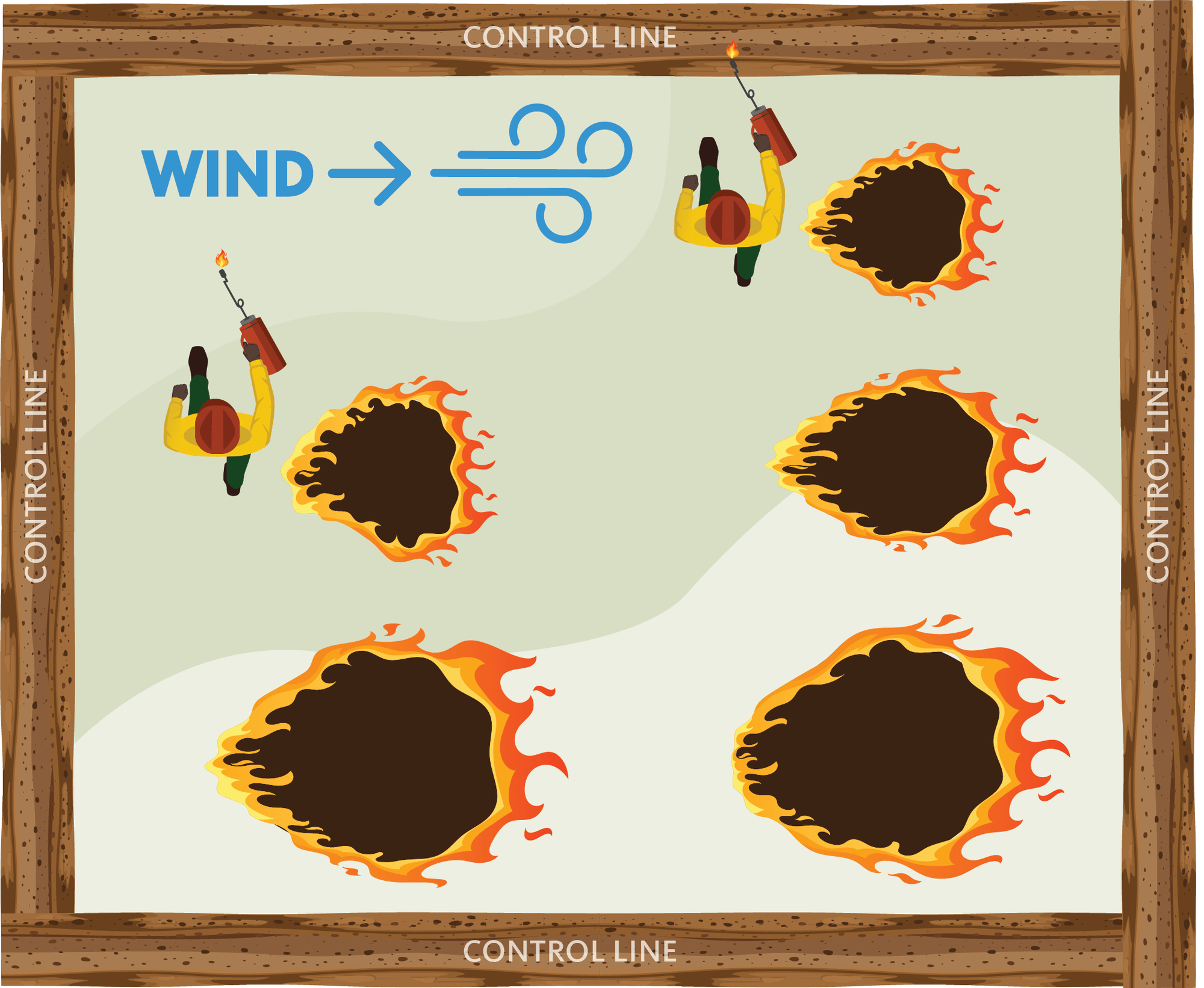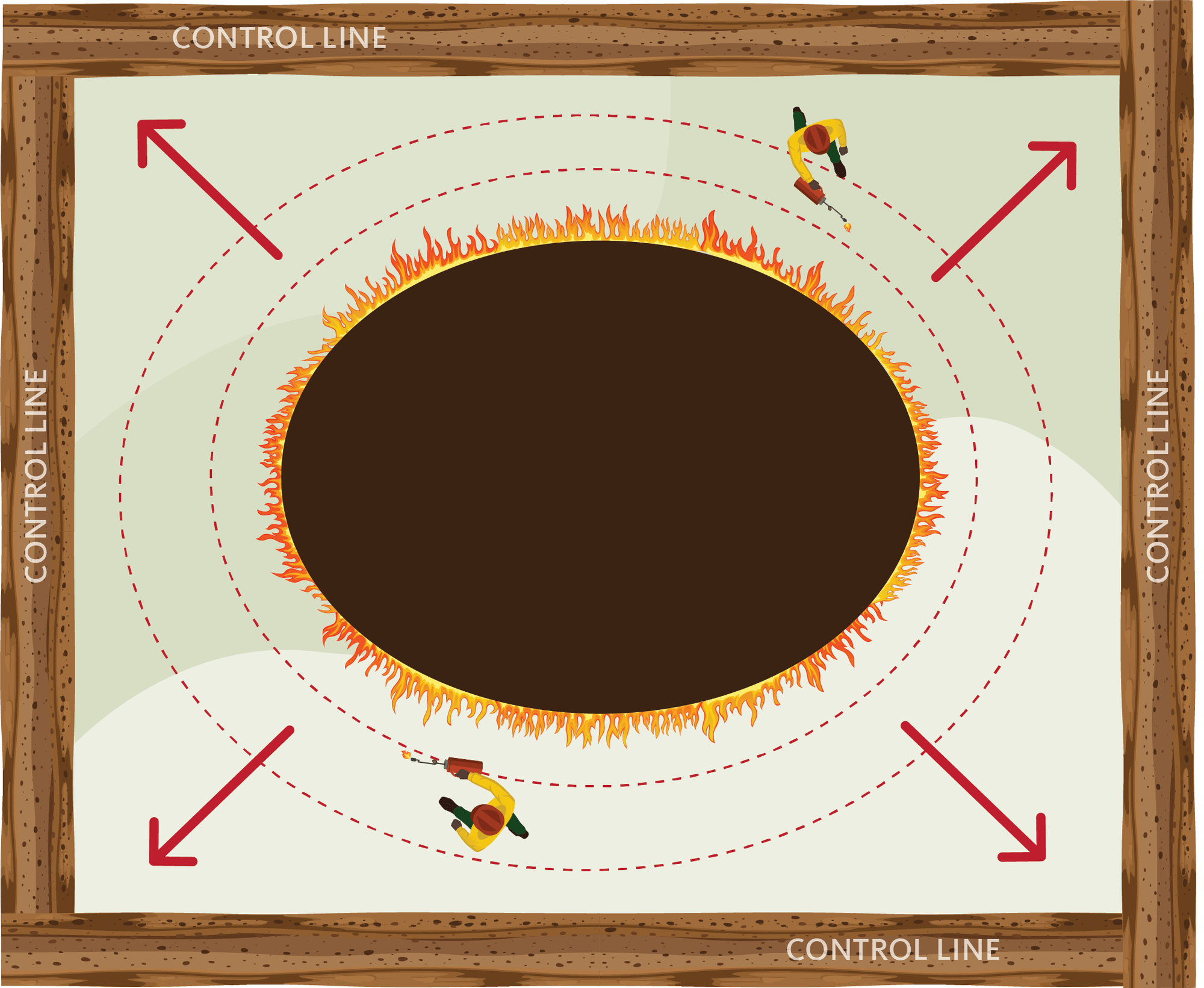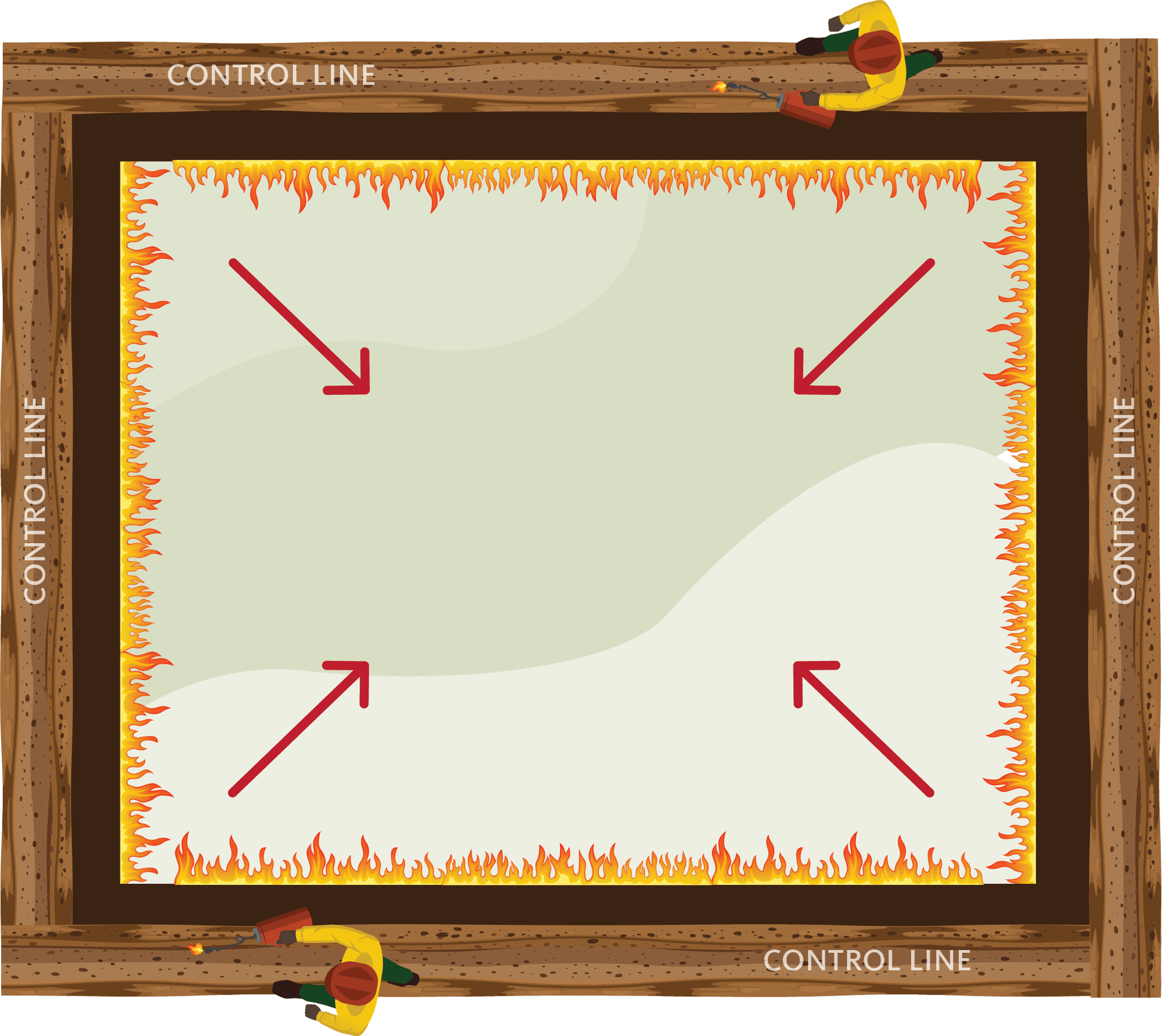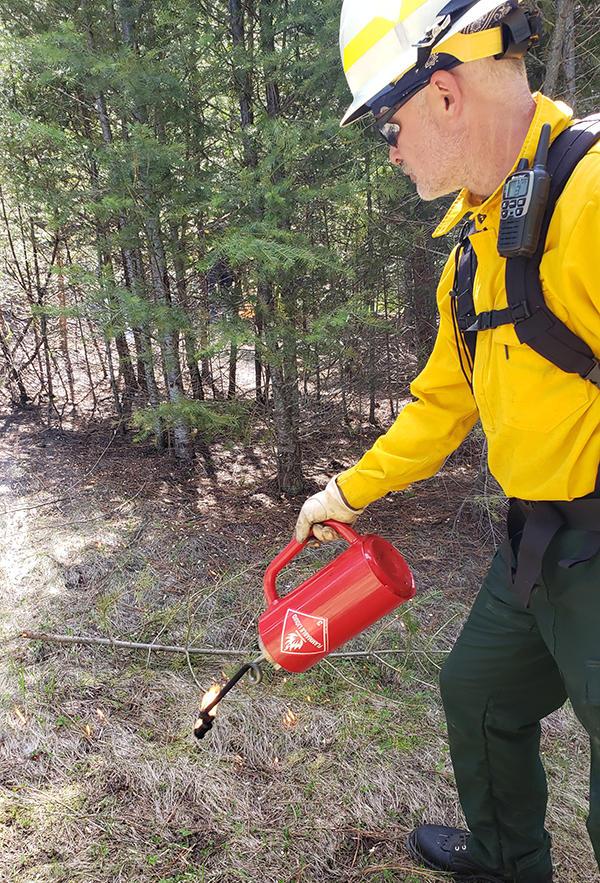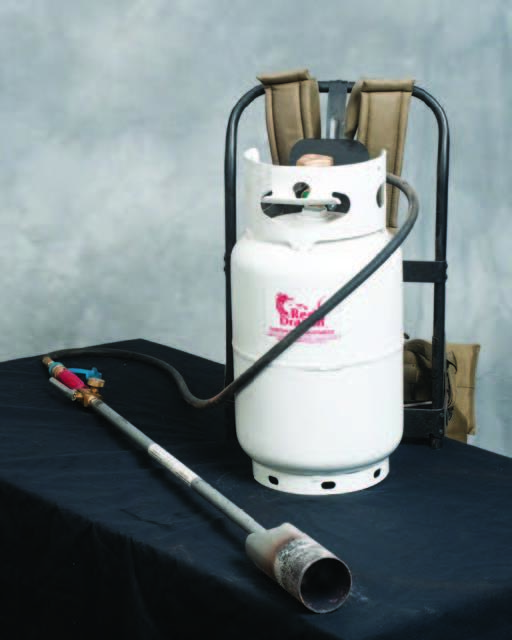Using the right ignition techniques and tools will help increase the chances that a prescribed burn meets the objectives of the burn plan. Burn managers consider several factors when developing a plan. These include:
- Surface fuel characteristics.
- Weather conditions.
- Smoke management guidelines.
- Resources and equipment availability.
- Topography of the burn area.
The ignition plan for the burn day will call for specific techniques, firing patterns and tools. This is a component of the overall burn plan.
Types of fire spread
The prescribed burn manager must match the appropriate ignition technique to the expected fire behavior. Fire behavior is a function of the interaction between fuel, topography and weather conditions. Wind speed and direction have the most impact on fire spread. Fire can spread in three basic ways, based on its relationship to the wind:
- A backing fire moves against the wind or downslope in the absence of wind. Backing fires have the least intense fire behavior.
- A flanking fire moves at right angles to the wind or dominant slope and has intermediate fire intensity.
- A heading fire moves with the wind or upslope in the absence of wind. A heading fire has the most intense fire behavior.
| Backing fire (moving against windВ or downВ slope) | Flanking fire (moving at right angles to the wind/slope) | Heading fire (moving with wind orВ upslope) | |
|---|---|---|---|
| Fire intensity | Lowest fire intensity | IntermediateР’В intensity | Highest fire intensity |
| Flame lengths | Tends to have smaller flame lengths | Tends to have moderate flame lengths | Tends to have longer flame lengths |
| Rate of speed | Slowest rate of spread | Moderate rate of spread | Fastest rate of spread |
| Heat residence time | Longer heat residence time than a head/flanking fire | Intermediate heat residence time | Shorter heat residence time than a backing/flanking fire |
| Wind | Smoke dispersalВ can be limited in low winds. | Subtle changes in wind can have an adverse influence on fire behavior. | Wind shifts can increase potential for uncontrollable fire spread. |
| Misc. | Takes longer to burn a given area. | Challenges may occur if topographic changes induce head fires along the main flank. | Torching, spottingВ and large volume of embers |
Prescribed fire ignition techniques and patterns
Burn managers use several techniques to apply prescribed fire. Each technique applies to specific scenarios, and each will produce different outcomes. To meet objectives, prescribed burners should adjust their technique for different surface fuels, changes in fuel types and arrangements, shifting weather patterns and changes in topography. A well-developed ignition plan should account for potential adjustments during the burn. To maintain safety, ignition operations are anchored into safety zones and predetermined control lines (Planning a Prescribed Burn, EM 9343).
The stagger and spacing when igniting the burn are referred to as the ignition pattern. The pattern to which a technique is applied helps keep the burners safe. When thinking about the pattern on the land, ensure that everyone has a clear and direct path to safety through an escape route into the black burned zone.
Commonly used ignition techniques and patterns
Backing fires
Backing fires are ignited against a control line, like a road, along the top of the slope or on the downwind side of a burn unit, usually as a single line of fire. The rate of spread is slow, as the fire backs into the wind or down the slope. This ignition technique generally results in low fire intensity, low flame lengths and more complete fuel combustion. Typically, there is less tree canopy scorch and lower risk of losing control of the fire. However, the slow movement of the fire can overheat the top layers of soil and damage sensitive feeder roots. It may also allow smoke to linger near the burn area. The slow rate of fire spread increases the time it takes to complete burn units.
Flanking fires
Flanking fires are ignited as several simultaneous lines of fire set directly into the wind (or down a slope). The fire spreads in a V-shape behind the ignition team. While fire intensity is generally moderate, intensity does increase when nearby lines of fire merge. This technique requires a steady wind from a single direction. Understand that any shift in wind direction during this operation could result in a heading fire. Flanking fires can occasionally be used with light to moderate fuel loads under an overstory of large trees, since there is less risk of crown scorch. This technique requires a high level of experience and a solid understanding of fire behavior.
Heading fires
Heading fires are ignited on the upwind side of a burn unit, as either a solid line of fire or as a line of dot fires. Prior to starting a heading fire, reinforce the flanks and downwind side of the unit by creating a wide, blackened fire line. Heading fires produce high fire intensity, fast rates of spread and long flame lengths. The area burns quickly with good smoke dispersal due to convective lift. Heading fires can increase the potential for spotting across control lines. This technique is frequently used in moist or humid conditions and in nonforested areas because of the potential for residual tree damage. In grasslands, heading fires can result in less fuel consumption due to shortened residence time, which can be beneficial for habitat heterogeneity.
Strip-heading fires
Strip-heading fires are ignited as a series of lines spaced out from one another, perpendicular to the direction of the wind or slope. Each strip burns into the previous strip before flame lengths get too high or fire behavior gets too intense. This technique is commonly used when a backing fire would be too moderate, but a heading fire too intense. The distance between strips can be adjusted to maintain flame lengths within prescription parameters. Factors that might influence this distance include tree density and size, fuel quantity and arrangement, weather conditions, or differences in topography. This technique can maintain adequate smoke dispersal and keep heat from reaching tree crowns. This is a common pattern used on forested burn units, since it allows for a high degree of control over the fire’s intensity.
Point-source or dot fires
Point-source fires, also known as dot fires, are similar to strip-heading fires. But rather than lighting a line of fire, you drop individual dots of fire. This consumes less drip torch fuel and can reduce the overall intensity of fire behavior. When igniting point-source fires in a grid, the dots can burn together, creating small convergence areas where fire intensity briefly increases. The spacing and distance between each individual dot fire contributes to the overall fire behavior.
Ring or center fires
Ring or center fires create an airflow pattern that draws the flames toward the center of the unit, causing intense fire behavior. On larger units, the first ignition may begin in the center of the unit to create the initial convection column. Then, the burner can ignite rings progressively around the center ring, moving out toward the edge of the burn unit. On small units, only one ring around the outside of the unit may be ignited. This ring is allowed to burn inward, consuming the fuels within it. This technique can result in high fire intensity with rapid burnout. It can create a tall convection column to move smoke out of the area quickly. A ring fire will create indrafts on all sides of the burn unit that keep heat away from surrounding vegetation. Use caution with this technique, as fire whirls or smoke whirls are possible. As with heading fires, this technique is typically used on nonforested burn units.
Ring fire variation
On small units, only one ring may be ignited around the outside of the unit and allowed to burn inward to consume all the fuels within the ring. This technique can result in high fire intensity with rapid burnout and can create a tall convection column to move smoke out of the area quickly. A ring fire will create indrafts on all sides of the burn unit that keeps heat away from surrounding vegetation. Similar to heading fires, this technique is typically employed on nonforested burn units.
Exercise caution with this technique. Fire whirls and smoke whirls are possible.
Prescribed fire ignition tools
Choose the appropriate tools for the burn and become familiar with their use, maintenance and safety procedures. This will help meet the prescribed burn objectives. Any time you use ignition tools, wear personal protective equipment, including fire-resistant clothing, long sleeves, eye protection, gloves, a helmet and leather boots. You will need matches or a lighter to start ignition tools. You can also use these to ignite small patches of dry fine fuels, such as cured grass, if needed. Drones and helicopters can also be used to ignite prescribed burns, but are not covered here.
Tools commonly used for prescribed fire
Drip torches
Drip torches are the most commonly used hand-held ignition device. Drip torches are easy to maintain and have relatively few parts that would require repair. Drip torches use a mixture of diesel and gasoline combined at the proper ratio to achieve burn objectives. This ratio is based on fuel moisture and the selected ignition technique and pattern. A common ratio is 4 parts diesel (which provides longer residual burn time) to 1 part gasoline (which helps carry the flame). When temperatures warm, adjust the ratio to adhere to the vegetation and sustain longer burning. In cool, wet conditions, adjust the ratio to use more gasoline, which will allow for quick ignition of vegetation. The igniter will walk along, dripping the fuel mixture from the canister onto the fuels to create the desired ignition pattern.
Fusees or flares
Fusees or flares are relatively inexpensive, lightweight, handheld ignition devices similar to road flares. These are commonly used in fine fuels, such as grasses, or in rough topography. They are easily stored and carried over long distances. They have a short — but very hot — chemical flame that can burn for about 10 minutes. Prescribed burners use fusees and flares for short-duration projects. They help ensure all fuels are consumed on the interior of the burn unit.
Propane torches
Propane torches are a cost-effective option for burning relatively fine fuels, such as grasses, that do not require much effort to ignite. They are also good for lighting sparse fuels and have a low residual burn time. They produce a hot, pressurized flame. Most propane torches are attached by several feet of hose connected to a small fuel tank fitted with a regulator. The fuel tank can be mounted on a backpack frame or carried by hand, depending on the terrain. These are commonly used in pile burning operations but are also effective on broadcast burns.
Putting it all together
A detailed ignition plan, incorporated into the overall burn plan, will describe the actions of this phase of the prescribed burn. Consider the overall burn objectives when determining the most appropriate techniques, patterns and tools.
On the day of the burn, crews will start with a test fire in representative conditions. This can help verify that fire behavior is as expected and falls within the prescription. Each crew member will monitor fire behavior and weather conditions. This information ensures crews adjust their techniques, patterns and tools as the burn is ignited to achieve the desired outcomes.
